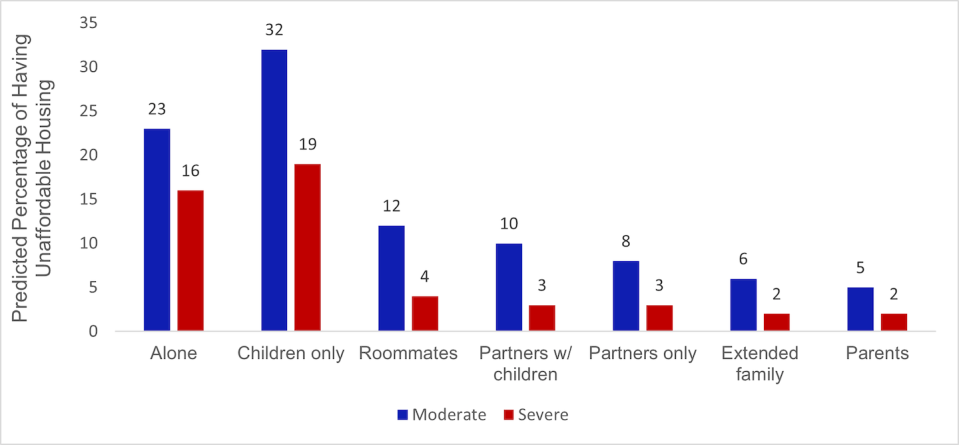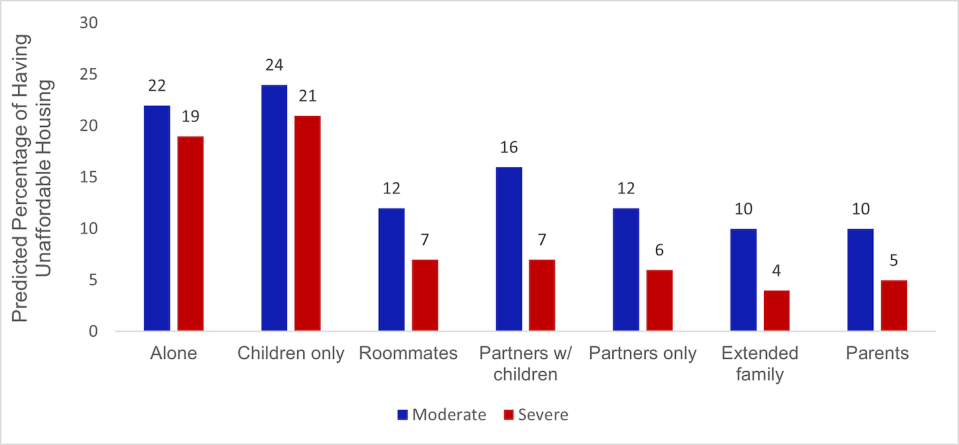Canadian young adults who live alone are more likely to struggle with unaffordable housing, study finds

Canada is experiencing a housing affordability crisis. Over the past 20 years, housing prices have increased at double the rate of income growth. Partly fuelled by dramatic interest hikes, rental prices have also risen precipitously in recent months. In March 2023, the year-over-year rent increased by 9.7 per cent.
Young adults are among the groups most adversely affected by the housing crisis. One in five young adults live in unaffordable housing and spend 30 per cent or more of their pre-tax income on housing costs.
Rising housing costs, declining real wages and increasing job instability have been identified as key reasons why young adults have limited access to affordable housing.
During this time, Canada has also witnessed the diversification of young adults’ living arrangements. More young adults live with their parents, extended family or roommates, primarily because there is a greater need to pool resources to cover high housing costs.
A young adult’s living arrangement is the product of their ability to transition into an adult economic role and gain access to private safety nets during financial crises.
The diversification of Canadian young adults’ living arrangements during the housing affordability crisis raises two questions. First, among young adults, who are the ones with the highest risk of having unaffordable housing? Second, to what extent does living with family or roommates reduce young adults’ risk of having unaffordable housing?
Young adults’ housing vulnerability
Our study addresses these questions by documenting variations in young adults’ risk of having unaffordable housing according to their living arrangements. We focus on young adults between 25 and 34 years of age.
We show that young adults living alone with their children have the highest predicted risk of having unaffordable housing. Over half of Canadian-born young adults living alone with their children live in unaffordable housing. Those who live alone are a close second: 38 per cent of young adults who live alone do so.
Living with parents, extended family or roommates reduces young adults’ predicted risk of having unaffordable housing. However, the protective effect of living with parents or extended family is greater than that of living with roommates. For example, seven per cent of Canadian-born young adults living with parents live in unaffordable housing compared with 16 per cent of young adults living with roommates.

Unequal risks based on nativity status
Many foreign-born young adults come to Canada without their parents or without having extended family in Canada. As such, these young adults may not be able to pool resources with parents or kin to cover housing costs.
Due to labour market discrimination, others may not have access to the financial resources necessary to establish independent households. They may also have fewer social ties in Canada, meaning that they have limited access to information about housing vacancies.

Our findings reveal that foreign-born young adults are generally more likely than Canadian-born with the same living arrangement to live in unaffordable housing. Fifteen per cent of foreign-born and seven per cent of Canadian-born young adults who live with their parents live in unaffordable housing.
Those who live alone with their children are an exception. Foreign-born young adults who live with their children only are less likely than their Canadian-born peers to live in unaffordable housing. This is partly because a higher share of foreign-born single parents have been previously married.
Particularly concerning is that foreign-born young adults with housing unaffordability issues are disproportionately more likely to have severely unaffordable housing, spending at least half of their pre-tax income on housing.

Reducing housing vulnerability
Canada is implementing its National Housing Strategy, which aims to invest at least $82 billion to address the housing needs of Canadians. Within this strategy, young adults have been identified as one of the groups with the most unmet housing needs.
When implementing this strategy, the Canadian government should increase the supply of affordable housing units that meet the housing needs of young adults in Canada.
In particular, the government should create more affordable housing that can accommodate young adults who live alone or only with their children. Doing so will reduce young adults’ risk of having unaffordable housing and the burden it places on families by forcing them to subsidise the housing needs of young adults.
Read more: How Canada plans to break records with its new refugee targets
To fuel the post-pandemic economic recovery, Canada is aiming to welcome 500,000 new immigrants a year by 2025. Immigration and Settlement Services should consider allocating more resources to address the housing needs of these newcomers into Canada.
Doing so will protect immigrants from having severely unaffordable housing and ensure that housing affordability in Canada does not erode any further. Access to affordable housing will create an environment where young adults and all Canadians can thrive.
This article is republished from The Conversation, an independent nonprofit news site dedicated to sharing ideas from academic experts. The Conversation has a variety of fascinating free newsletters.
It was written by: Kate Choi, Western University and Sagi Ramaj, University of Toronto.
Read more:
Ethno-racial minorities in Canada have less access to affordable housing than white people
New study reveals intensified housing inequality in Canada from 1981 to 2016
Kate Choi receives funding from the Social Sciences and Humanities Research Council.
Sagi Ramaj has previously received funding from the Social Sciences and Humanities Research Council.


